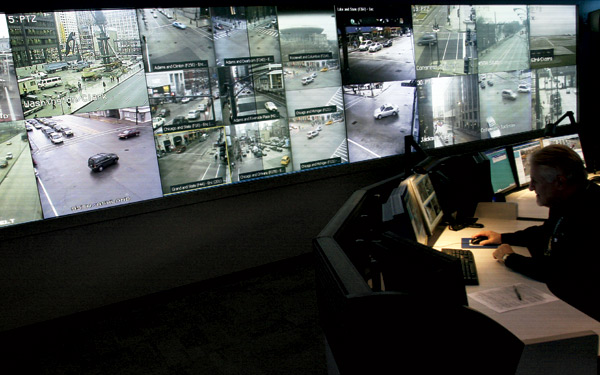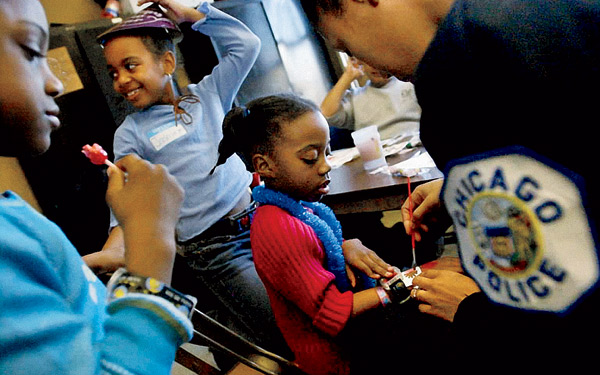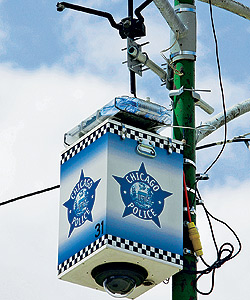
They’re watching you: Inside the Office of Emergency Management and Communications
On a cool night last September, Alderman John Pope (10th Ward) and two police officers met with 20 or so people from South Chicago, a neighborhood reeling from months of violence. “I’ve lived here my entire life,” one woman told them, “and I’ve never seen anything like this.”
Over the spring and summer, gangs in the neighborhood—along the lake, ten miles south of the Loop—had grown frighteningly bold. Six people had been murdered since June, 12 people over the previous eight months. On Labor Day, ten-year-old Nequiel Fowler was shot and killed as she stopped to tie her blind sister’s shoes.
The meeting, part of a citywide community policing program, was held in the basement of Immaculate Conception Church, 2944 East 88th Street, and the large space looked a bit like a classroom: residents arranged in a few rows of folding chairs, all of them facing police officers who sat behind a metal table. Outrage over Nequiel’s murder had brought more people than usual to the meeting and her death loomed over the conversation. She was killed, the police say, when an alley became a battleground for the Latin Kings and Latin Dragons.
At first, Pope and the officers encouraged the group to attend an upcoming court hearing for the four men arrested in the shooting. But the residents seemed uninterested and distracted. Several of them looked down, avoiding eye contact with the officers. Never mind the murder trial—what was protecting them from violence like this? What would save them from the shooters they’d never see? One man stood up and asked whether or not a city surveillance camera had anything to do with the arrests.
It was a fair question. Several of the blinking boxes now towered over the modest homes and stores of South Chicago, and they had been installed with a promise of helping prevent crime. At the very least, they were supposed to help during an investigation. Did a detective tapping into the city’s surveillance network see Nequiel’s killers? Did the zoom lens capture the license plate of a suspicious car? “Did it help at all?” the man asked.
“No,” Alderman Pope replied. The shooters were outside the camera range. “Information from neighbors was the key.”
Just a few years ago, meetings like the one in South Chicago were an integral part of a program called CAPS (Chicago Alternative Policing Strategy), started in 1993, that emphasizes police and community partnerships to prevent crime. But today, so-called community policing is being challenged like never before. Last fall, the city slashed its CAPS budget and delivered another, equally powerful blow: a hiring freeze on all but a small number of new officers.
Now, the city that pioneered community policing is blending in another innovative approach that relies on cameras, artificial intelligence, and global positioning systems. At presstime, a plan was under way to install surveillance cameras in 281 squad cars, or one for each of the city’s police beats. “I don’t know if we’ll ever get back to community policing because of its cost,” says Freddrenna Lyle, a South Side alderman (6th) who presides over some of the city’s most violent communities. “It’s scary. We are moving toward the Big Brother concept.”
Photograph: Joshua Lott/Reuters
|
|
Right now, so-called “geeks with guns” in the Crime Prevention Information Center at the police department’s headquarters are monitoring street corners from their office chairs, mouse-clicking from camera to camera, checking on sensors that listen for gunshots. Similarly, officers in some police districts are using surveillance cameras synched to their desktop computers to watch for suspicious activity. A few months ago, the city rolled out “video analytics,” a pilot computer program that trolls through infinite hours of video, looking for suspicious people, objects, and behavior. In the future, the city hopes that officers in the field will be equipped with handheld devices that access the entire camera network. Schools, businesses, and homeowners have connected their private surveillance cameras to the citywide system.
“The technology that we’re seeing now is really just in its beginning stages, and I think it will only be limited by our imagination,” says Chicago police superintendent J. P. “Jody” Weis. “We have to be creative because the criminals are creative, and I think the cameras are going to make a huge difference in how crime is fought.”
Chicago has never been shy about its use of crime-fighting technology and “intelligence-led policing.” But the city has long championed CAPS and technology, a blend of the two. The recent budget moves suggest the years of balancing megabytes and manpower are over. “It’s easier to put a camera up to watch over a neighborhood than it is to put a police officer on the corner,” says Isaac Carothers, the West Side alderman (29th) who chairs the city council’s police and fire committee. “Not that it’s necessarily more effective. But it is less expensive.” By Carothers’s estimation, an officer costs at least $100,000 a year, a sum that includes training, salary, and benefits. A surveillance camera costs about $13,000—and that figure is likely to drop, police officials say, as the technology gets cheaper.
Weis says he wants to continue to push the concept of intelligence-led policing, using real-time information to guide police resources. “What I want is to get to the point where we are developing intelligence that allows us to take action and move resources based on that—with the ultimate goal of being able to get ahead of the crime,” he explains.
The stakes are high. Four years after leading the country in murders, Chicago had made steady progress toward distancing itself from the dreaded moniker of “murder capital,” dropping from 601 murders in 2003 to 445 in 2007, its lowest murder total in four decades. Last year, however, the city’s homicide total rose about 15 percent to 510 murders, just 12 shy of New York, a city with nearly triple the population of Chicago. And while some might feel inclined to blame the spike in violence on last year’s wretched economy, it’s worth noting that other big cities—Baltimore, Cleveland, Milwaukee, Los Angeles, and Philadelphia, even Detroit—had fewer murders in 2008 than the year before. Two cities that had led the nation in per capita murders, New Orleans and Gary, Indiana, also saw fewer killings.
Meanwhile, the police department’s leadership has gone through its own rapid and significant changes. Though it may have been a coincidence, the 15 percent murder spike also happened in the same year that the department struggled to adjust to new leadership under Weis, a former FBI agent and the first outsider to run the department in 40 years. Arrest numbers were down. Some officers publicly blamed the decrease on a less aggressive approach, a position inspired by low morale, little faith in leadership, and a lack of manpower. Weis, invoking his frequently used explanation, says 2008 was a year of transition. “I was new; I was learning the department. In 2009, the transition is over; it’s now a year for results.”
* * *
Photograph: AP Photo/Charles Rex Arbogast

Under the CAPS program, beat officers are hands-on with the residents of high-crime neighborhoods.
Once a novel tactic drawn up by criminologists and police officials, CAPS meetings became a highly touted part of Chicago law enforcement and, eventually, a model for police departments across the country. The idea was to create a formal process through which communities could work with police to solve problems and rebuild themselves.
The key attraction was the holy grail of law enforcement: stopping crime before it happens. Ideally, at a monthly CAPS meeting, officers and residents interact and build the community trust that leads to meaningful tips—hearing about a drug dealer’s plan to launch an open-air drug market, for example, or getting a heads-up on someone who is threatening his neighbors.
CAPS also aims to bring officers and residents face to face, reshaping the perception of police and the work they do. One of the greatest obstacles to effective police work, criminologists say, is the public’s attitude toward law enforcement. “If a community doesn’t respect its officers, it doesn’t respect their work, and it certainly doesn’t respect the law,” says Arthur Lurigio, a criminologist at Loyola University Chicago. “What you have then is a community that won’t follow the rules, a form of anarchy.”
The interaction between cops and the community helps hold all participants responsible, too. “I don’t know of any place in the country where there’s this kind of accountability between the public and public officials and public employees,” says Wesley G. Skogan, a Northwestern University professor who has studied CAPS since its inception. “It’s where people meet and discuss monthly, and get after each other about their performance.”
That said, no one who has studied the CAPS program would suggest that beat meetings work consistently for everyone. Attendance waxes and wanes depending on the criminal activity in a neighborhood. Officers sometimes outnumber the residents. Neighbors sometimes tie up officers’ time reporting on broken park benches and potholes. In high-crime neighborhoods, residents are often scared to attend. Anyone can come to a beat meeting, and criminals or their emissaries have been known to listen in. Still, when CAPS was launched in five police districts in 1993, crime dropped more in those districts than others with similar demographics and lawlessness. Within a year, CAPS was deployed citywide.
But money has now become an issue. Last August, Weis announced a subtle but potentially seismic change: The department would no longer pay officers overtime to attend beat meetings or CAPS events that weren’t on their shift. In October, the city slashed the overall CAPS budget from $6.6 million to $5.3 million and cut its staff from 72 employees to 54. (In 2000, the CAPS budget was $9 million.)
Before the cuts, residents at CAPS meetings had a chance to talk with officers from all three shifts—early, middle, and late—and get to know the different police officers who worked at different times in their neighborhoods. Under the new CAPS plan, only a sergeant working at the time of the meeting, typically the late night or “third watch” shift, would be under orders to attend.
“I just don’t see how we can take community policing seriously anymore,” says the Reverend Marshall Hatch, whose church is in the high-crime Austin neighborhood, “and the sad part is: Community policing is the one way we can stop this violence.”
* * *
Photograph: Chicago Tribune photo by Candice C. Cusic
|
|
Daley officially hired Weis in November 2007, luring the muscular Florida native away from the FBI with a $310,000 salary and the presumptive mandate to clean up the department, polish its battered image, and rebuild its relationship with the community. The mayor’s unorthodox move was questioned almost immediately. “There are police officers out there who have made more arrests in one year than the average FBI agent will make in his entire career,” says Bob Weisskopf, president of the Chicago Police Lieutenants Association. “To be held accountable by someone who the bulk of the department feels is less of a police officer, well, that kind of gets them upset. Morale is as bad as it’s ever been.”
At the same time, Weis’s order to clean up the department grated on some cops, who claimed to worry that the new administration would be reluctant to support an officer who wasn’t operating strictly by the book. “There is more of a hands-off policy to the public than before,” says Mark Donahue, president of the Fraternal Order of Police. “Narcotics arrests are down; traffic stops are down.”
After deadly shootings at last summer’s Taste of Chicago, aldermen blasted Weis at a special city council hearing in July, particularly criticizing his decision to replace 21 of 25 district commanders. The housecleaning—presumably aimed at repairing the department’s reputation—removed much of the police leadership that saw murder rates drop between 2003 and 2007. “Some of the moves just didn’t make sense,” says Carothers.
Cuts to the community-policing program received less attention from the aldermen, perhaps because its mission and results are harder to quantify. How do you measure whether a relationship is working and how can you explain such a thing to a City Hall bean counter? “CAPS is a long-range, proactive prevention strategy,” says Carl Bell, a violence prevention expert at the University of Illinois at Chicago. “But the problem is that you might not see the fruits of your labor for a year or two. Prevention is always the first thing to go.”
Weis says the cuts have made CAPS more efficient, especially because plans call for sergeants to attend every meeting. “Now, you have decision makers there,” he says. “When they hear about a problem, they can address it with the community.”
Predictably, the cuts were blamed on the city’s $469-million budget deficit, but the new no-overtime policy suggests that more is at play. Though overtime expenses fluctuate, the cost of sending extra officers to CAPS meetings has been between $600,000 and $1.5 million a year, a small piece (0.125 percent) of the police department’s $1.2-billion budget. What’s more, the city is spending money elsewhere. Weis has announced plans, of course, to install $5,500 cameras in hundreds of police vehicles. In early December, the city signed a $59.2-million contract with a suburban dealership to buy Chevrolet Tahoe SUVs, with the plan to phase out squad cars.
Has “the budget” become just an easy way to explain a new policy that moves the police department away from community policing? Criminologists have wondered whether Weis’s FBI background tilts him toward a more military-style organization and a dependence on technology. “Working in the FBI is dramatically different from running a police department,” says Craig Futterman, a University of Chicago professor who studies Chicago law enforcement. “This aggressive, military style could be a result of the fact that Weis doesn’t understand the situation he’s in. So he’s going with what he knows.”
Last April, Weis ordered something akin to a paramilitary assault on crime: helicopter patrols of South and West Side neighborhoods and, on the ground, officers dressed in full riot gear. Weis has also floated a plan to equip officers with M4 assault rifles, a weapon used by the U.S. Marines.
Some criminologists argue that Weis is moving the department toward so-called professional policing, an approach popular in the 1960s, ’70s, and ’80s and inspired by theories that cops performed more ethically, efficiently, and safely when they minimized their interactions within the community. “The FBI, to my knowledge, has never been about community partnerships,” says Lurigio, the professor from Loyola University. “Their work isn’t about reaching out to people and building relationships with the community.”
One of the ramifications of this type of professional policing is, potentially, a one-sided police department. “I don’t believe that you can go one direction or the other, either heavy-handed enforcement or softer policing,” says Lurigio. “Why does it have to be one or the other? There is no evidence that technology alone makes a difference in the crime rate. You use the tools that work under the circumstances. You need a big toolbox to be effective in a big, complicated city like Chicago.”
Weis insists that he supports community policing and says his goal is to blend programs like CAPS with intelligence-led policing that is technology driven. “If we cultivate the type of relationships that I want to have with the community, if the trust is built up and the public feels confident that they can pick up the phone and call a policeman, they can point us right to where the crime is,” Weis says. “If you look at intelligence policing, a key component of that is the community, and community involvement.” Nonetheless, the emphasis on technology seems to be taking hold.
Photograph: Taylor Castle
* * *
In fact, Chicago’s cybersleuth plan was launched nearly a decade ago. It began, in part, with the creation of the Office of Emergency Management and Communications (OEMC) and the million-dollar buildout of a network of underground fiberoptic cables designed to allow the sharing of surveillance among its police, fire, and other departments. After 9/11, federal funding bolstered the city’s defense and surveillance strategies.
Today, Chicago’s surveillance network is widely regarded as among the finest in the nation, if not the world. Inside the command center at OEMC at 1411 West Madison Street, the main control room is designed like the hull of a ship with dedicated sections for police, fire, and other city services. A staffer tracking, say, the route of a fire truck can follow its path on monitors as long as there’s a camera within 150 feet of the vehicle. The picture quality is almost as good as a household television. (The police department has the smaller but similar control room, the Crime Prevention and Information Center, or CPIC.)
Besides being less expensive, cameras are believed to have several other benefits. First, there’s the general idea that the very sight of the machines will deter crime because people are less likely to misbehave when they feel as though they’re being watched. Criminologists believe that the overall effect is to transform once blighted corners, alleys, and the like into safe spots where law-abiding behavior can take over. Second, cameras can be used to move crime away from certain areas, and funnel it toward spots where police might have an easier time making an arrest: forcing drug dealers, for instance, toward a dead-end street where they’d have a tough time making a getaway. Surveillance video can also make for solid evidence in court. “Rather than having the guys do surveillance on the street, they are sitting back and watching it on the cameras,” Weis says. “They’ve got the cars identified, they know who to go after, and they can arrest the people.”
So much surveillance raises serious privacy issues, of course, and every technological development seems to push society closer to the dreaded Big Brother universe. But from a strictly law enforcement perspective, the criticism of camera surveillance starts with an obvious but essential fact: A camera cannot make an arrest. Beyond that, how often does a camera prevent a crime? On some streets, criminals are confident that, even though they’re being recorded, their crimes will go unpunished. “In some parts of my ward the guys are so bold they’ll commit crimes right underneath the cameras,” says Alderman Walter Burnett Jr. (27th). “They know where the blind spots are.”
And who is actually watching the video feeds? “As the camera network continues to grow and grow and grow, you’re faced with that concern: How do you view so many cameras with a limited amount of resources?” says Ray Orozco, commissioner of the OEMC. “The answer to that is simple: We use technology to review technology.”
Beginning late last year, Emergency Management began a slow rollout of a $550,000 federally funded program called video analytics, a form of artificial intelligence that searches the video surveillance system for specific video cues. In real time, the system can now set up a perimeter around a portion of the city, an “electronic fence,” and sound an alert when, say, a red truck passes through. On a more local level, a camera on a street corner can be programmed to look for signs of a fight—perhaps by focusing on images of a group moving together. The system can also troll through thousands of hours of archived footage. As an example, Orozco described how authorities were trying to determine whether someone had buried something in a popular city park. Using video analytics, they gave the camera system an “inject,” the image of a shovel, and had the system troll through months of prerecorded footage. (Nothing was found.)
City officials won’t reveal the exact number of surveillance cameras in place in the city’s 234 square miles, claiming they don’t want to reveal blind spots in coverage. Nor is it easy to determine how much the city spends on surveillance. Much of the network has been paid for with federal money or tucked into various city department budgets. On a neighborhood level, for instance, aldermen can set up cameras with money from their ward budgets, and there doesn’t seem to be anyone specifically accounting for these local expenditures.
What’s more, the city’s network is being bolstered by various city departments and entities: the Chicago Transit Authority, Navy Pier, McCormick Place, Soldier Field, and so on. And Orozco says the police department has started linking the system with private security cameras, those owned and operated by businesses, schools, and even everyday citizens. Last fall, Charles Hill, who has lived in West Chatham with his wife and three boys for the past 13 years, became the first homeowner to connect to the OEMC’s system. His six cameras—installed at a total cost of about $3,000—are trained on his treelined sidewalk, the alley to the west, the industrial street to the south, and the vacant lot to the north. Each camera can capture footage up to 200 yards away. “It’s going to serve the block far greater than it will serve me,” Hill says. “This block can be too damn quiet. Things happen and no one sees them. Now we’ve got a chance to identify anything illegal.”
* * *
At the next month’s CAPS meeting in South Chicago, about 20 people gathered, once again, in the basement of Immaculate Conception Church. A cool October breeze blew in from a set of open doors, and this time the room was arranged differently, as if someone was hosting a banquet. The residents sat in circles around two small tables and four police officers, all of them from the third watch, gathered behind a larger table at the front of the room.
Officer Juana Cuadrado began by announcing another court appearance for the men charged in the Nequiel Fowler shooting. If enough people were interested in going, Cuadrado said, the alderman’s office might pay for a school bus to take everyone to the courthouse. The discussion then moved to another staple of CAPS meetings, a rundown of arrests and the number of calls made to police. Since the last meeting, there had been 46 arrests, 19 juvenile arrests, and 2,522 calls for service.
The numbers didn’t sound right. The residents looked at Cuadrado in disbelief. “I know you guys are frustrated with police not being there,” Cuadrado said quietly.
“What’s going on?” one man asked. “We used to have over 100 arrests a month.”
“The budget’s been cut,” one of the beat officers replied. “There was a newspaper article about it. Jody Weis is cutting the budget again; they’re retiring officers and only hiring 200 new ones. We’re going to be short 800 officers. But why don’t you come and look at the nice camera I have in my car?”
The second beat officer added: “They have a GPS system so they can know where we are. So any incident that anyone has a complaint about, if it happens in front of the car, the whole incident will be videotaped.”
The residents shook their heads in disgust. “You think they can pawn that bean we have downtown?” one resident asked sarcastically, referring to the Cloud Gate sculpture in Millennium Park. “So they could pay for more officers?”





